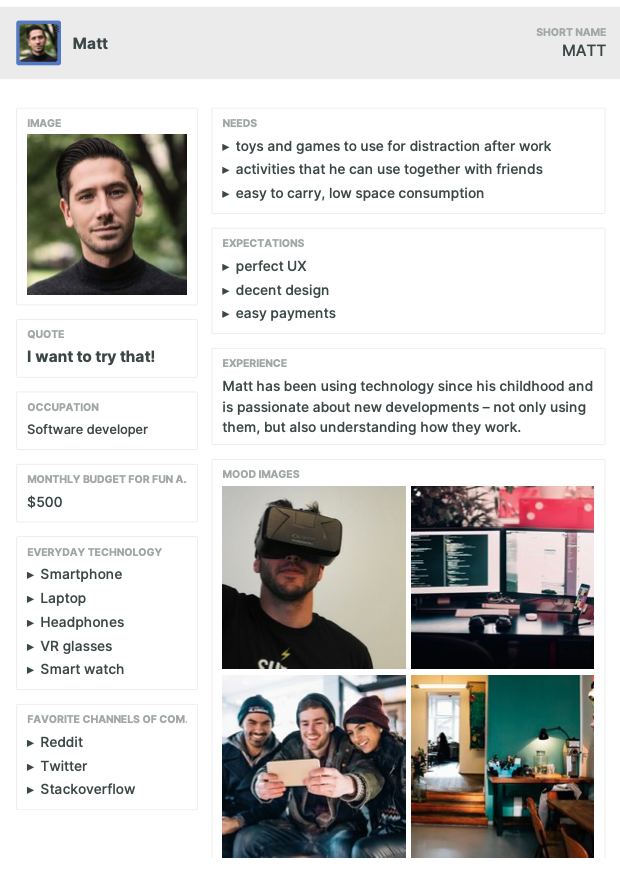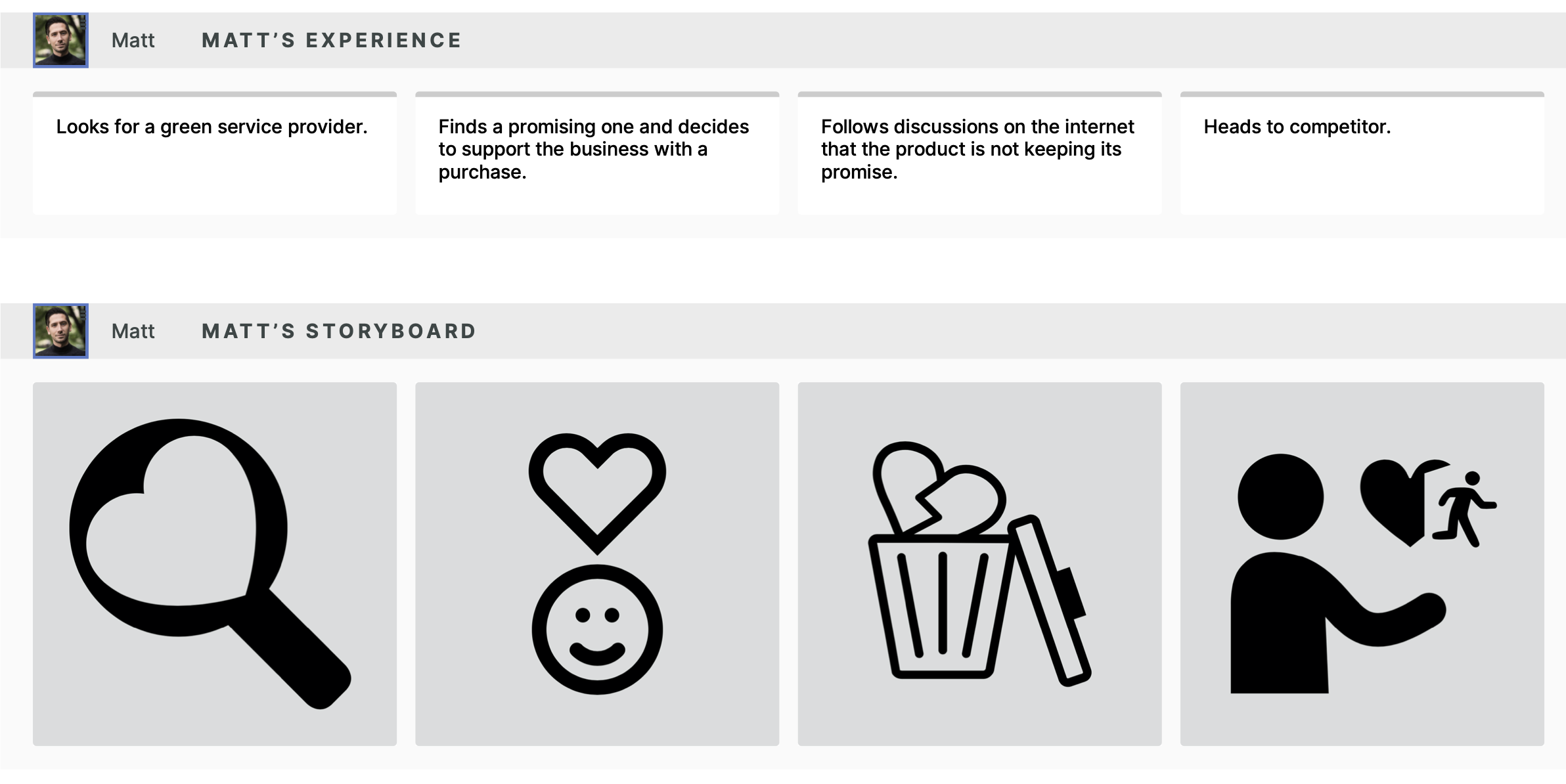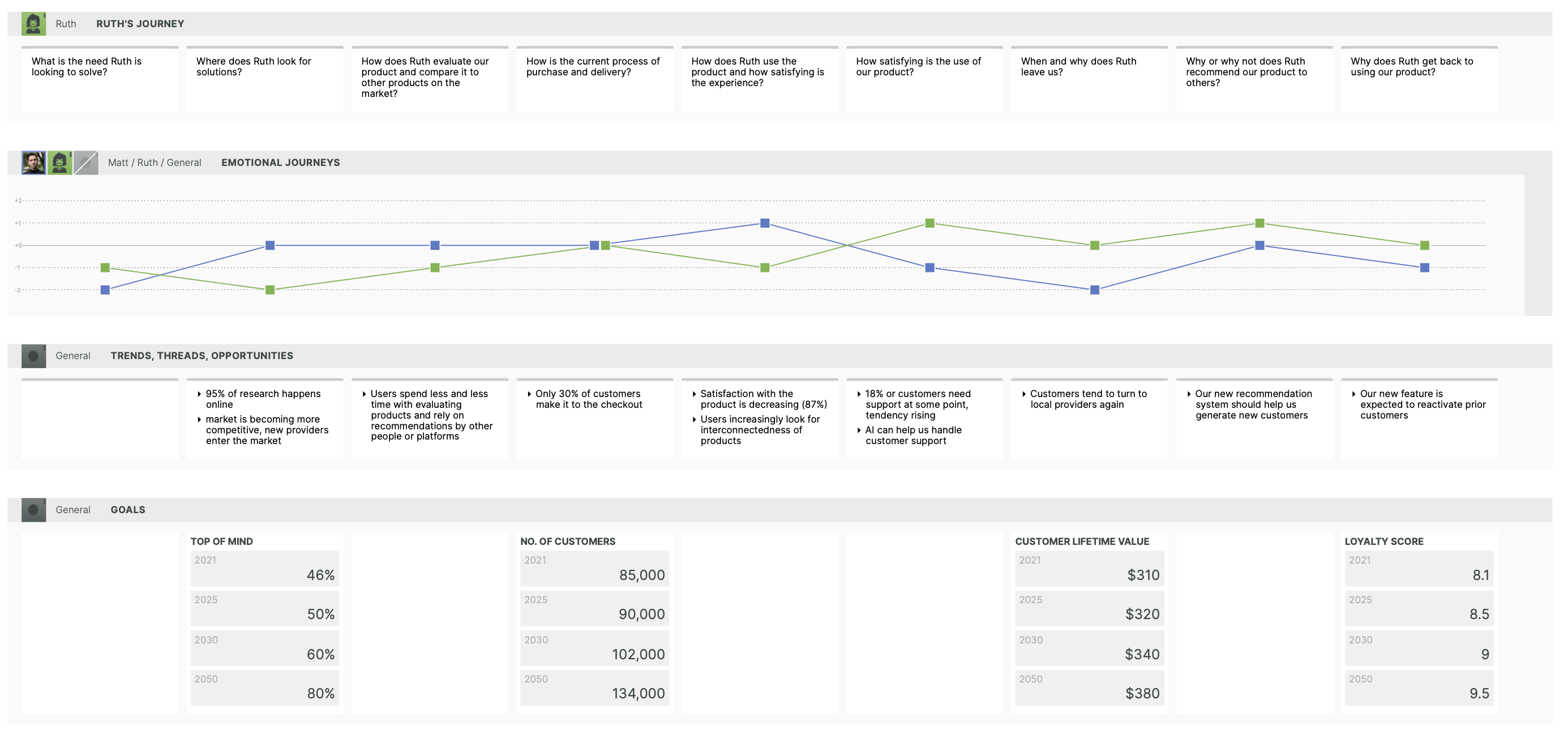Journey mapping in strategic planning
Customer centricity is the core of every successful business. Only if we plan and deliver products that solve real customer needs, our business will survive in the long run. Hence, having a clear understanding of what the customer needs and how we can meet these needs better than any other actor on the market is key to sustainable success.
In this article, we'll discuss:
- Journey mapping in the context of strategic planning
- Questions to solve in strategic planning
- How to create a journey map for strategic planning
- Example journey map for strategic planning
- Challenges when using journey mapping for strategic planning
- Summary
Journey mapping in the context of strategic planning
The role of journey mapping for developing good business strategy is essential and strategies with their foundations based on customer needs and context will have much greater chances of success. The better we understand our customers and what they need help with, the more likely we are to design products and services that will be useful, functional and something which they love to receive. Positive service experiences improve the chances of our customers choosing us over other providers in the market and helps us to gain a competitive advantage.
Hence, strategic journey maps are useful tools for companies in different states of existence and within different contexts:
- For start-ups and pioneers to help develop their business model, align their product or service to their target persona’s needs and create a first prototype
- For established companies, to actively review and innovate their long-grown customer experience and uncover potential for innovation
- For large companies, to communicate the company/product vision to all different levels of employees and give them a common understanding and shared perspective
- For global companies, to better visualize the experiences they deliver across markets on different zoom-levels
- For consultancies, to create a pitch for their client, create a common understanding of the planned activities and vision and improve collaboration
But how does a strategic map differ from the operational maps we use every day?
Operational maps, e.g. the ones we use in journey map ops, help us keep an overview of different ongoing projects and coordinate them. They give us a very clear picture of affected actors and their responsibilities.
Strategic maps help us better understand the big picture. They exist to evaluate our service delivery from a high level and align it with our overarching vision, rather than focussing our attention on minor details of our product or service. A strategic journey map takes our customers perspective and uses it to sharpen the aim of our product or service:
What will customers expect from us in the future and how can we meet those needs so that we are able to outperform our competition?
We recognize the level of strategy of a map by the frequency in which its content changes: With our operational maps we might work with them with a high frequency as it's content can change on a weekly or monthly basis. A strategic journey map is focused on the long term and is more likely to have slight adaptations on a yearly basis – unless the market experience radical change, where it might need more significant alterations to reflect the changing context.
There are many overlaps between operational and strategic journey maps – they compliment each other as operational maps are able to break down our strategic maps into manageable sections and give life to our overarching strategy.

Questions to answer in strategic planning
A journey map for strategic planning should give us a long-term perspective on what we want to do, need to do, and will do in order to solve our customer's pain points while at the same time making decisions that drive the success of our organisation. Therefore, strategic maps must have a basis in customer needs, consider external market factors and attempt to build a holistic product or service that unites them.
WHO ARE OUR CUSTOMERS?
The better we understand the experiences our customers are going through, the more we are able to empathize their situation and develop services that will accurately meet their needs. Creating personas helps us develop this understanding: it gives us a clear picture of our customers’ needs, drivers and expectations. Working with personas makes us aware of the different experiences that our customers have and what we need to do to align our business model and actions with their specific needs.

Our customers’ problems are the reason why our organization exists – solving them on different levels will determine how successful our organisation will be in the long run.
Creating personas and basing the customer journey on them helps us to point out:
- What customers should be at the focus of our activities? What customers should not?
- How different are our persona’s needs and how can we serve them?
- Who are our future customers? What do their needs look like and how are they different from nowadays?
- How will our personas develop? How will their needs, behaviour patterns, and pain points change in the future? Which trends will impact which of our personas?

WHAT SHOULD WE IMPROVE ABOUT OUR SERVICE?
Knowing what the current pain points of our customers are will give us action potential to make positive changes that will make our service more enjoyable to receive as well as generating a loyal customer base.
Maybe it turns out that we actually already meet our customers' high-level needs – but we still see a high fluctuation in our customer retention rate and our customers are choosing to opt for our competitors services. In this case, journey mapping can help us compare the experiences we deliver to the experience our competitors are offering. Maybe it’s not the product itself we need to change, but rather some tweaks in delivery are needed?
Especially in highly competitive markets, where there are only slight differences in the products themselves, the experiences customers have along the way can make or break our success.
Journey mapping can help us learn:
- How is the experience that comes with our product or service, beyond the product or service itself?
- How does our customer experience compare to the journey people have with our competitors’ products?
- How does our business model perform when it comes to survive on the market or to outperforming our competitors?
- What do our customers expect in 5, 10, 20 years? How do we need to change the way we deliver services in order to meet these goals?

ARE OUR VISION AND MISSION ALIGNED WITH OUR CUSTOMERS NEEDS?
The purpose of our organization, and everything we do should be based on a strong vision and mission. Good vision and mission statements are more than simple catchlines that decorate our office walls. Coherent vision and mission statements, when used well, can be valuable reference points that guide and give purpose to our organization. They help us define the present, articulate a compelling vision for the future and create the space for a strategic pathway that connects the two.
A decent journey map can be a great source of insights for us to refine our vision and mission by bringing into focus the following questions:
- Are our actions aligned to our vision and mission?
- Do the experiences we provide to our customers demonstrate that we are following the right path?
- Are the vision and mission aligned with our customers, or do we need to refine or challenge the statements?

WHAT IF?
Considering potential scenarios can uncover potential for innovation or additional products of services that will assist our customers towards the outlined vision. What could happen in the next 5-10-20 years that impact each step? What do we need to keep on our radar?
Journey mapping helps us understand how we need to adapt our product to meet the future requirements of different scenarios:
- What if we experience a strong rise of a specific technology?
- What if competition or substitutional products get stronger?
- What if we must keep up with emerging communication and distribution channels?
- What if social trends change?

How to create a journey map for strategic planning?
Strategic journey maps, like any other journey map, have the customer's emotional journey and satisfaction at their heart. However there are also other pieces of relevant information that we can include in a strategic map that give it depth and aid our ability to use it as a foundation for great decision making.
GOALS AND KPIs
Assumption-based journey maps are fine if we are looking for some creative inspiration, however we want to use a journey map to derive decisions from, it must have strong foundations in qualitative and quantitative research. We need to dig into numbers, conduct interviews with customers and employees, … but then, in order to not drown in all this data, cluster and condense the data, and derive the most important numbers from it.
We need to break it down to the most important KPIs and make them our main control tool and goal for the next planning period.
Including KPIs into our journey maps can also help us prioritize projects and dedicate our tangible, intangible and human resources to them. Do we need to grow the team that is taking care of a specific experience, do we need to invest more of our budget?
THREADS, TRENDS AND OPPORTUNITIES
Innovation is a core component of great strategy as well as good service delivery.
If we are able to come up with creative solutions to our customers' needs we are able to benefit both them as customers, as well as ourselves as service providers.
Keeping a clear picture of threads, trends and opportunities that might affect the experiences people have with our service helps us go beyond a product focussed mindset, a look more broadly at new ways in which our service can be delivered and innovated. This can include new technologies, new competitors, or changed living habits.
Drafting a strategic journey map can be inspiring and create the conditions for us to be creative. It can break ruts in product development, drive collaborative efforts and bring unique perspectives to old challenges. Using the flow and noting down ideas allows a lot of potential for innovation. And in times of rapid change, being able to innovate and adapt is not only important, it is imperative.
STAKEHOLDERS
If we want our business to be successful in the long run, we will be dependent on a range of different stakeholders. From motivated employees across all departments, trusted suppliers, national and local governments, cooperative creditors and investors, and finally with our customers.
In the long run, the formation of these constructive relationships won't happen by chance – rather, they need to be understood, evaluated, invested in and managed properly.
Adding a stakeholder lane to our journey map helps us to understand what stakeholders are involved in what step of the journey and how they influence the backstage processes of the customer journey. Or even, what stakeholder should be involved, even if they are not yet. When it comes to stakeholder understanding it can also be interesting to look inwards and assess which internal stakeholders should have a say when it comes to a specific step of the customer journey.

Augmenting our strategic journey map with a stakeholder map can also help us get a clear idea of our service ecosystem, understand how the different stakeholders connect, and uncover gaps and synergies.

It can also drive us to ask, what stakeholders, or what skills do we need? What connections do we need to create, what skills do we need to build or purchase?
Example journey map
This is an example of a journey map in the context of strategic planning based on customer needs.

Expand the example journey map
Challenges of introducing journey mapping in strategic planning
COMBINATION WITH TRADITIONAL PLANNING MODELS
A journey map is not the only document that is needed for strategic planning, rather it supplements our other tools by visualizing gathered data and serving as a communication tool for customer experience. A well researched journey map compliments and amplifies the effort we put into other planning and decision making activities, e.g. doing a market analysis.
When we consider journey mapping as complementary, rather than threatening to existing methods we work smarter and see less resistance as we integrate it as a practice in our organization. Using a variety of tools and methods is always beneficial – all of them have their own focus and value, there's not the one-fits-all approach.
Triangulating between various strategic planning tools help to overcome shortcomings of one single tool.
Developing a clear strategy means digesting a lot of complex information and a journey map helps us by breaking it down to chewable pieces. Still, for a proper strategic analysis we will still need to analyze our industry, competitors, our resources and competences and our internal management system. This will give us loads of detailed information which would just overwhelm a journey map.
STRATEGIC PLANNING IN SMALLER BUSINESSES
Many smaller businesses do strategic planning according to their implicit expertise – they can hold back their success by assuming they ‘simply know’ the market well enough. Even if this was true in the moment when they developed their first business plan, when they spent months and years analyzing the market and developing a product that meets customer needs – rapid market change can swiftly change the context in which they are working. If this understanding is not regularly challenged, knowledge can easily turn it into assumption.
Also, many smaller organizations underestimate how much implicit knowledge they don’t share with each other and have insufficient tools to explicitly communicate their strategy to the team.
Journey mapping can not only help to clarify changing customer expectations – but also express and communicate strategy to the entire organization.
A journey map can help clearly express knowledge that is otherwise drowned in the everyday hustle and, by doing so, help the entire team get on the same page. With a common understanding we have better opportunities to identify gaps, collaborate and aim for improvements in our service delivery.
A journey map can be a great tool to:
- State the focus customer group / persona and create empathy
- Create a shared perspective through a shared narrative
- Communicate the vision of activities
- Set a shared language
BREAKING IT DOWN TO CHEWABLE PIECES
The good thing is: high-level journey maps like the company strategy journey map rarely change. This means that, once we have our high-level journey map set up, we only need to slightly update and maintain it. The next step to make our strategic maps more actionable is to journey map down into smaller pieces, sub-journeys and tasks, that we can work on. For example, if we’re confronted by an unsatisfying return rate, we need to zoom into the customer experience, understand why this is happening – the pain points of customers – and then derive a future state journey map that will provide us with an action plan to improve the issue.
For such complex journey maps with advanced lane and content types like the ones mentioned above, it's crucial to use a digital journey mapping solution. To make it easier for you to choose one, we collected the best journey mapping platforms in this piece.
Summary
A strategic journey map will show the overarching journey we are attempting to help our customer with. It can also serve as a complementary, visionary tool that shows how the status quo can be pushed towards a better future.
By taking sections of this journey we are able to isolate and innovate particular aspects of a customer journey as well as connect the dots in a strategic way that helps people towards intended outcomes.
In the end, an organization needs both: a strategic plan based on customer needs that helps develop a long-term vision, as well as a way to make this plan operational and which helps to orientate and manage our organisational activities so that we continue to deliver positive outcomes for both us and the customers we serve.
“Give me six hours to chop down a tree and I will spend the first four sharpening the axe.”
Abraham Lincoln
And now?
Now it's about implementing what you've just learned: Create strategy journey maps to better understand your customer's experience and innovate your services.
The journey mapping tool Smaply lets you easily create journey maps, personas, and ecosystem maps.
Sign up now, it's free!











